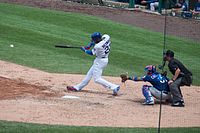
Photo from wikipedia
Background: Anterior cruciate ligament reconstruction (ACLR) is the gold standard treatment for ACL tears to allow baseball players to return to sport (RTS). The optimal graft type and femoral tunnel… Click to show full abstract
Background: Anterior cruciate ligament reconstruction (ACLR) is the gold standard treatment for ACL tears to allow baseball players to return to sport (RTS). The optimal graft type and femoral tunnel drilling technique are currently unknown. Hypothesis: There is a high rate of RTS in professional baseball players after ACLR, with no significant difference in RTS rates or performance between cases and controls or between graft types or femoral drilling techniques. Study Design: Cohort study; Level of evidence, 3. Methods: All professional baseball players who underwent ACLR between 2010 and 2015 were included. Demographic and performance data (pre- and postoperative) for each player were recorded. Performance metrics were then compared between cases and matched controls. Results: A total of 124 players (mean age, 23.7 ± 4.1 years; 83% minor league players) underwent ACLR. Of these, 80% returned to sport (73% to the same or higher level) at a mean 310 ± 109 days overall and 333 ± 126 days at the same or higher level. The most common graft type was an ipsilateral bone–patellar tendon–bone (BTB) autograft (n = 87; 70%). A total of 91 players underwent concomitant meniscal debridement or repair. No significant difference in any of the primary performance metrics existed from before to after ACLR. Compared with matched controls, no significant difference existed in RTS rates or any performance metrics after ACLR. No significant difference existed in RTS rates or primary performance outcome measures between graft types or femoral drilling techniques. Conclusion: The RTS rate for professional baseball players after ACLR was 80%. No significant difference in performance metrics existed between BTB and hamstring autografts or between femoral drilling techniques. Furthermore, no significant difference in performance or RTS rates existed between cases and matched controls. Femoral drilling technique and graft type did not affect performance and RTS rates in professional baseball players after ACLR.
Journal Title: Orthopaedic Journal of Sports Medicine
Year Published: 2019
Link to full text (if available)
Share on Social Media: Sign Up to like & get
recommendations!